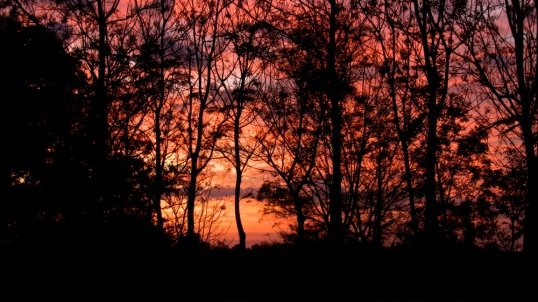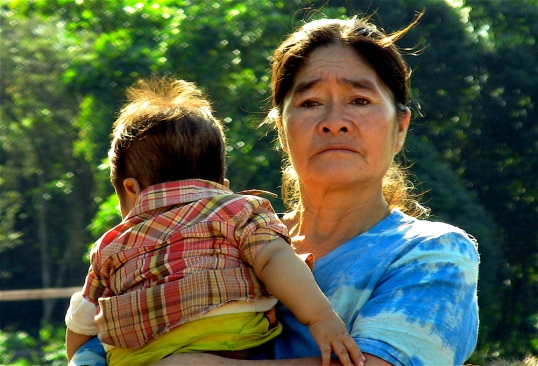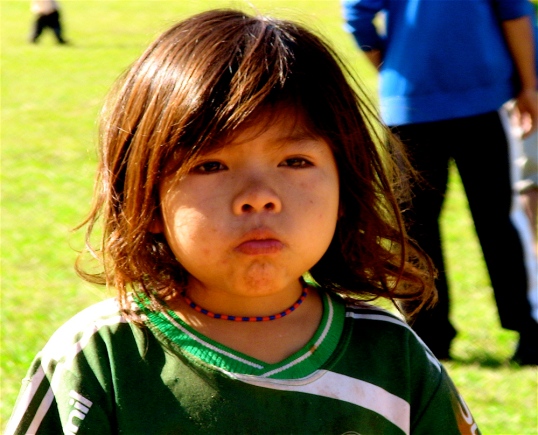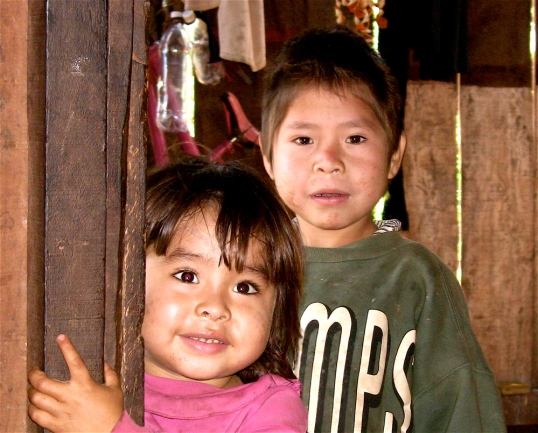I’m writing this intermittently, as I have to stop every few moments to scratch the multiple oozy mosquito bites covering my body. I look like I’m recovering from the chicken pox, but each bite was well worth the four days I just spent exploring Mbaracayu, the largest remaining stretch of native forest in Paraguay. This UNESCO biosphere reserve, managed by the Fundacion Moises Bertoni, covers approximately 340,000 hectares, bordering Brazil to the East.

Sunrise in Mbaracayu
Numerous indigenous communities in varying stages of poverty and pain abut the Mbaracayu reserve. These communities, most of them Guarani, have lost much of their land to surrounding cattle ranches and the rampant deforestation that continues to afflict the native forest outside the reserve. With their land goes much of their culture – though traditions and beliefs vary from region to region, connection to nature is crucial. For centuries the indigenous people depended on nature to provide for them, and they cared for nature in return. I won’t preach to you here about the history of the conquistadors, colonialism, missionaries, and other factors that have led to the current realities faced by the indigenous peoples.
We stopped in with our video camera at a Guarani community to speak with the cacique (community leader) and his family. Even the strongest heart drops a little at the sight of how little these communities have – Tacuari is the poorest community in the region, and possibly in the country. Houses are shabbily constructed out of wood scraps, with dirt floors and a mattress if they are lucky. If there is no wood available, the homes are tents constructed out of garbage bags. This may be adequate for the scorchingly hot summers, but when the temperature drops to two degrees celsius in the winter and the rains flood the lowlands, they are literally left out in the cold. Most of the children don’t have sufficient clothing for colder weather.

An Ache woman and child
The Cacique and his family explained that they often lack food, and have very little land. They are boxed in on all sides by large proprietors with little access to their traditional methods of subsistence. They have land specifically allotted to them by the government, which they are not supposed to rent out, but which they do, for a pittance. The Cacique says they need more assistance, more money and more food from the government. He was forthcoming in the interview, but as one learns very quickly, not every sad story is 100% true – people fall into the roles they think are expected of them, in the hopes that they will receive more in return. As one of our friends from a local NGO told us, many of the communities ask for continued assistance but don’t show any inclination to work to improve their situation. They want all their problems to be resolved through free handouts. It’s hard to imagine that they are not telling the entire truth, but of course there are many dimensions to every problem – back again to the “colonization and extermination” issue.
The Ache people have a slightly different story. Until not so very long ago (the mid 70’s), the Ache were a people brutally persecuted on their traditional lands. Paraguayans thought of them as nothing better than “Guayaki” or “forest rats” – a racial slur that was used for decades. They were hunted, killed, and enslaved for sport, and their communities live to bear the scars. In the face of violent discrimination, they have organized themselves and improve their circumstances. We spent a few hours speaking with leaders in the community of Arroyo Bandera.

She's got her eye on the candy
Hunter-gatherers by custom, the Ache in the Mbaracayu region have maintained their traditional hunting rights within the reserve – they hunt only with their handcrafted bows and arrows. And yes, they are damn good at it. The Atlantic Forest plays an important role in their customs, and they are deeply tied to nature as a source of life. For example, a woman who is about to give birth will accompany a hunting trip into the forest for several days. Whatever she eats the most in her last days of pregnancy (armadillo, deer, wild pig perhaps) is the name given to the newborn child. Of course these names were not shared with us as outsiders. We met “Juan”, “Pablo” and “Carlos” but no one introduced themselves by their traditional name.

Loving the camera
Though poor, and constantly struggling to protect the forest they depend on, the Ache always have a smile to share. (This may be because we brought them a soccer ball and school supplies.) One of the caciques invited us into his one room home to charge our camera while we played with his eight beautiful children. The gales of giggles they shared with us when they saw video footage of themselves was priceless. Sitting back here in my apartment in the city, I only hope we can make a real difference, to conserve the remaining forest so these children can continue the traditions of their people.
Mom just sent me your blog address and Helen I must tell you….your adventures sound amazing. You’ve seen and done so much in such a short time. Good on ya and congratulations!! The photos are beautiful and I look forward to seeing more. You take good care of yourself and be well.
Love,
Sandy
Hi,Searching the web for articles about the “ache” your excellent blog came up! I just want to say that I appreciated what you had to say about the Ache at Arroyo Bandera. You are balanced and I appreciate your thoughts about Paraguay and the challenges that conservationist face here.I have lived among the Ache for over 30 years working in holistic sustainable community development and have interacted with all the ache communities over this time, but our main work has been with the Southern group of Ache at Puerto Barra.(close to Santa Rita.)I am a photographer by vocation, but I work with a faith based NGO,and over the years have networked with the WWF, Nature Conservancy and also the FMB(Fundacion Moises Bertoni)and also shoulder to shoulder with various anthropologists in various advocacy venues in favor of the Ache as they struggle to come to grips with the globalized world. Once again my best wishes to you, and continued to keep up the good work! Bjarne Puagi.